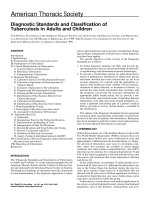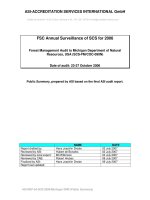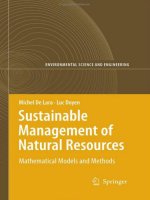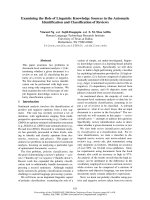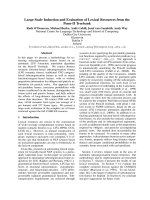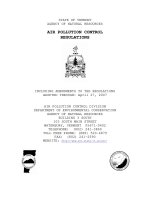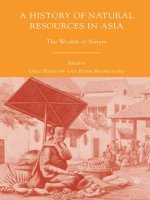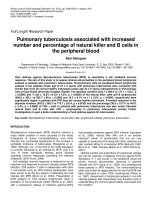Concept and classification of natural resources
Bạn đang xem bản rút gọn của tài liệu. Xem và tải ngay bản đầy đủ của tài liệu tại đây (1.49 MB, 34 trang )
NATURAL RESOURCES
Natural Resources
And Human Histor y
Over one hundred sixty thousand years ago, our ancestors
probably began to use flint, chert, and obsidian to make tools.
Metals were first used more than 20,000 years ago.
Copper and gold were the earliest metals used.
By 6000 years ago, our ancestors extracted copper
by smelting.
Before another thousand years had passed, they
had discovered how to smelt lead, tin, zinc, silver,
and other metals.
Natural Resources And
Human Histor y
The technique of mixing metals to make alloys came
next.
Bronze was composed of copper and tin.
Pewter was composed of tin, lead, and copper.
The smelting of iron came much later—about 3300
years ago.
The first people to use oil instead of wood for fuel were
the Babylonians, about 4500 years ago.
The first people to mine and use coal were the Chinese,
about 3100 years ago.
What is a natural
resource?
Any form of matter or energy obtained from the physical
environment that meet human needs.
Those things that people come in contact with that may
be used to perform any useful function.
Objects, materials, creatures, or energy found in nature
that can be put to use by humans.
Natural Resources
Natural resources are things that are found in nature and
useful to people.
We need natural resources to live. Natural resources are
things that people and animal can’t live without.
Natural Resources
Water is a natural resource. We
can not live without it!
Natural Resources
Other natural resources are plants
and soil.
Natural
Resources
Animals and fish are also natural
resources.
Natural
Resources
Some natural resources like oil and
coal will be used up if we are not
careful.
Natural
Resources
Natural resources can be made into
things we use.
Usefulness Changes
Things that affect our definition of
usefulness.
Religion- Hindu- cattle
Custom- Dogs as food source.
Technology and Science
Resources or natural resources are any form of
matter or energy obtained from the physical
environment that meet human needs. This
definition of natural resources is not as simple as it
appears. Most resources are created by human
ingenuity. Oil was once a useless fluid until humans
learned how to locate it, extract it from the ground,
and separate it by distillation into various
components such as gasoline, home heating oil, and
road tar.
Similarly, coal and uranium were once
useless rocks. Something may become
useful or useless for human needs as a
result of changes in the technology of
resource extraction and processing
Whether something is classified as a
resource depends on technology,
economics, cultural beliefs, and the
environmental effects of finding and using it.
On the basis of their stages of developments,
resources can be classified into both Actual and
Potential resources:
The resources pass through various stages of
development before they are actually available. The
resources held actually in stock are called Actual
resources. Even the actual source of resources may
not be possible to be used to their full. The portion
that can be used profitably with the help of
available technology is termed as Potential resourcs.
The size and quantity of a potential resource may
change with changes in technology and time.
Natural capital
Natural resources are natural capital converted to
commodity inputs to infrastructural capital processes. They
include soil, timber, oil, minerals, and other goods taken
more or less as they are from the Earth.
Natural resource
classification
Natural resources are often
classified :
Renewable and Nonrenewable Resources
Renewable resources can be
replenished over fairly short spans of
time, such as months, years, or
decades.
Nonrenewable resources take millions
of years to form and accumulate.
Major types of
Natural
Resources
Perpetual
Resources
Renewable
Resources
Non-renewable
Resources
1.
Renewable Natural Resources: Replenished over short periods
of time
Sun, wind, water, trees perpetually available
Timber, water, soil Take months or years to
replenish themselves.
If we are not carefully we can use these up or destroy them so
they can’t replenish themselves
Mismanagement of renewable resources may turn them into
nonrenewable.
Over-pumping groundwater ruins vegetation
creating deserts.
Clear cutting forest & not replanting
2. Nonrenewable Natural Resources: Not replaced in a useful time
frame. Are formed FAR more slowly than we use them (they can &
will run out)
Mineral ores, fossil fuels (coal, oil, natural gas)
The maximum rate at which a renewable resource
can be used without impairing or damaging its
ability to be renewed is called its maximum
sustained yield. If this yield is exceeded a potentially
renewable resource is then converted to a
nonrenewable resource.
Finding Substitutes and Alternatives for Scarce
Mineral Resources
Recycling involves collecting and remelting or
reprocessing a resource, whereas reuse involves
using a resource over and over again in the same
form.
Resources can be classified on
biotic and abiotic:
Biotic resources are derived from animals and plants
(livingworld).
Abiotic resouces are derived from the non-living world
e.g. land, water, and air. Mineral and power resources are
also abiotic resources some are derived from nature.
Resources can be classified on
Earth resources:
Three major categories of
Geologic Resources:
1.
2.
3.
Energy
Metallic
Non-metallic
All are non-renewable resources
(time needed to create >>> time needed to consume)
Earth Resources can be classified:
Perpetual or Renewable
Exhaustible or
Direct solar energy
Nonrenewable
Indirect effects related to
Minerals
hydrological cycle, e.g., wind,
Metallic:
tides, running water etc.
Ferrous,
Nonferrous
Potentially
(or Polymetallic),
Exhaustible/
Precious
Renewable
Nonmetallic:
Fresh Air
Industrial, Gemstones
Fresh Water
Energy Resources
Fertile Soil
Biodiversity
Radioactive Minerals
Fossil Fuels:
Coal, Oil and Natural Gas
